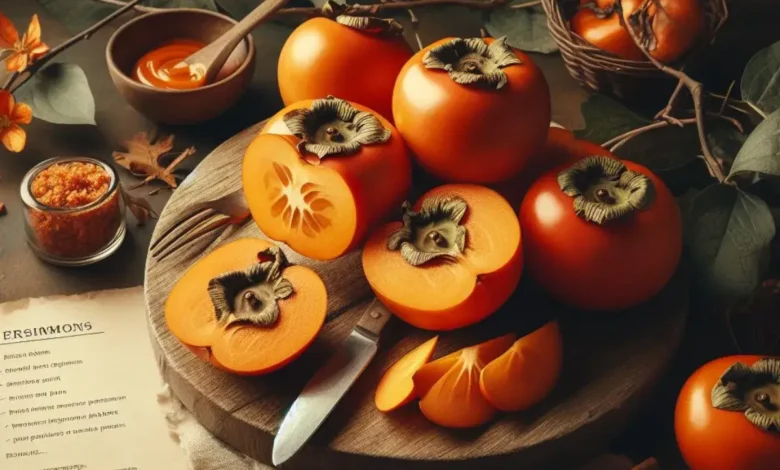Persimon Delights: 5 Irresistible Recipes You Must Try Today

Persimmon Delights: 5 Irresistible Recipes You Must Try Today Persimmon
Are you looking for a delicious and versatile fruit to add to your recipe collection? Look no further than the persimmon! Persimmon, also known as persimmon or diospyros kaki, is a vibrant orange fruit that is both tasty and nutritious. In this article, we will explore the origins and health benefits of persimmon, as well as provide tips for cultivating persimmon trees and identifying ripe fruits. Additionally, we will share five irresistible persimmon recipes that you must try today. Let’s dive in!
What is Persimmon?
Persimmon, scientifically known as Diospyros kaki, is a fruit that belongs to the genus Diospyros. It is commonly referred to as persimmon or kaki persimon. The fruit originates from East Asia, particularly from Japan where it has been cultivated for centuries. Persimmon is often mistaken for a tomato due to its round shape and bright red color when ripe. However, once you taste it, you’ll quickly realize that it is a unique and delicious fruit.
Origins of Persimmon
The origins of persimmon can be traced back to Japan, where it has been grown for over a millennium. The Japanese have a deep appreciation for persimmon and have developed various cultivars that are enjoyed for their distinct flavors and characteristics. Persimmon trees were later introduced to other parts of the world, including Europe and the United States, and are now widely cultivated in many countries.
Health Benefits of Persimmon
Not only is persimmon a tasty treat, but it also offers several health benefits. This fruit is an excellent source of dietary fiber, which is essential for maintaining a healthy digestive system. It is also rich in vitamins A and C, which are important for promoting a strong immune system and healthy skin. Additionally, persimmon contains antioxidants that help protect the body against harmful free radicals. Incorporating persimmon into your diet can contribute to overall wellness and well-being.
How to Cultivate Persimmon Trees?
If you’re interested in growing your own persimmon trees, it’s important to know the basics of cultivation. Consider these important factors:
Choosing the Right Soil for Persimmon Trees
Persimmon trees thrive in well-drained soil that is slightly acidic. It is important to select a location with good drainage to prevent waterlogged conditions that can harm the roots. Additionally, persimmon trees prefer loamy soil that is rich in organic matter. Before planting, perform a soil test to assess the pH level and make any required adjustments.
Planting and Caring for Persimmon Trees

Plant persimmon trees in early spring or late fall, when the ground is not frozen. Dig a hole that is both wide and deep to accommodate the tree’s root system adequately. Place the tree in the hole, ensuring that the bud union is level with or slightly above the soil surface. Fill the hole with soil, gently compacting it to eliminate any air pockets. pockets. Water the tree thoroughly after planting and continue to water regularly throughout the growing season, especially during dry spells.
Harvesting Persimmon Fruits
Persimon fruits are typically harvested in the late fall or early winter, depending on the variety. The fruits should be allowed to fully ripen on the tree before harvesting. Ripe persimons have a vibrant orange color and a soft flesh that yields gentle pressure. To harvest the fruits, simply twist or cut them from the tree, leaving a short stem intact. Store the harvested persimons in a cool, dry place until ready to consume.
Amazing Persimon Recipes You Should Try
Now that you know more about persimon and how to cultivate its trees, let’s explore some delicious recipes that showcase this versatile fruit:
Persimon Smoothie Bowl
Start your day off right with a refreshing persimmon smoothie bowl. Blend together ripe persimmon, banana, and your choice of milk or yogurt until smooth. Pour the mixture into a bowl and top with your favorite toppings such as granola, sliced banana, and a sprinkle of cinnamon. This vibrant and nutritious bowl is a perfect way to get your daily dose of vitamins and minerals.
Persimmon Salad with Citrus Dressing
For a light and refreshing salad, combine sliced persimmon, mixed greens, and segments of your favorite citrus fruits such as orange or lemon. Drizzle the salad with a simple citrus dressing made from freshly squeezed lemon juice, olive oil, salt, and pepper. Toss the ingredients together and enjoy a burst of flavors and textures in every bite.
Persimon Crumble Tart
If you have a sweet tooth, this persimon crumble tart is a must-try. Prepare a crust using a mix of crushed cookies and melted butter, and press it into a tart pan. Arrange sliced persimon on top of the crust and sprinkle with a mixture of brown sugar, cinnamon, and a touch of lemon juice. Bake the tart in the oven until the persimon is tender and the crumble topping is golden and crisp. Enjoy it warm, accompanied by a scoop of vanilla ice cream for a delightful dessert experience.
Where to Find Delicious Persimon Recipes?

If you’re looking for more persimon recipe inspiration, there are several places to explore:
Exploring Persimmon Recipes on Pinterest 1
Pinterest is a treasure trove of delicious recipes, including many creative ways to use persimon. Simply search for “persimmon recipes” or related keywords on Pinterest to discover a wide range of ideas. You’ll find everything from smoothies and salads to baked goods and main dishes. Save your favorite recipes to try later!
Persimon Recipe Books and Websites
Many recipe books and websites offer dedicated sections for personal recipes. Visit your local bookstore or browse online to find cookbooks that focus on fruits and desserts. You can also check out reputable food websites for tried and tested persimmon recipes. With a bit of research, you’ll uncover a plethora of mouthwatering options.
Discovering Local Markets for Fresh Persimmon
If you prefer to taste persimmon in its natural form, consider visiting local markets or grocery stores that specialize in fresh produce. Look for ripe persimmons with a bright red or orange color and a firm consistency. Local farmers’ markets are another great option for finding high-quality, locally grown persimons. Don’t hesitate to ask the farmers for tips and suggestions on using persimons in your cooking.
Tips for Identifying Ripe Persimmon Fruits
While purchasing persimon fruits, it’s essential to know how to identify ripe ones. Here are some tips to follow:
External Appearance of Ripe Persimon
Ripe persimons have a bright red or orange color. Avoid fruits that are still green or have a pale color, as they are likely unripe and will have a bitter taste. Look for persimons with smooth skin and no signs of bruising or damage.
Touch and Texture Check for Ripe Persimmon
Gently press the persimmon with your thumb. A ripe persimmon should yield slightly, indicating soft flesh. However, it should not be mushy. Avoid fruits that are too firm or too soft as they may not be fully ripe or have started to spoil.
Fruit Color and Firmness in Ripe Persimmon

Observe the fruit’s calyx, the leaf-like structure at the top of the persimmon. This part should be dry and easily removable. Persimmons with a firm consistency are generally less astringent in taste compared to softer ones. Depending on the variety, the colors and firmness may vary slightly, but a ripe persimmon should generally exhibit the characteristics mentioned.
By following these tips, you’ll be able to choose the perfect ripe persimmons for your recipes and enjoy their delicious flavor to the fullest.
In conclusion, persimmon is a delightful fruit that offers both culinary and nutritional delights. Whether you enjoy it fresh, in smoothies, salads, or baked goods, persimmon is a versatile ingredient that adds a unique twist to any dish. Additionally, the health benefits provided by persimmon make it a worthwhile addition to your diet. So why not explore the world of persimmon recipes today? From smoothie bowls to crumble tarts, your taste buds will thank you. Happy cooking!
| Vitamin | Amount per 100g of Persimmon |
|---|---|
| Vitamin A | 81 µg |
| Vitamin C | 66.0 mg |
| Vitamin E | 0.73 mg |
| Vitamin K | 2.6 µg |
| Vitamin B6 | 0.1 mg |
| Folate | 8 µg |
| Niacin | 0.3 mg |
| Pantothenic Acid | 0.2 mg |
| Riboflavin | 0.02 mg |
| Thiamin | 0.03 mg |
FAQ
Q: What is the topic of this FAQ?
A: The topic of this FAQ is “Persimon Delights: 5 Irresistible Recipes You Must Try Today”.
Q: What does the term “kaki” refer to?
A: The term “kaki” refers to a species of persimmon fruit that is also known as “sharon fruit”.
Q: Are kaki and persimmon the same thing?
A: Yes, kaki and persimmon are different names for the same fruit. Kaki is the Japanese name for the fruit, while persimmon is the English name.
Q: What is the difference between astringent and non-astringent varieties of persimmons?
A: Astringent varieties of persimmons are high in tannins, which give them a bitter and astringent taste when not fully ripe. Non-astringent varieties, on the other hand, can be consumed when still firm and have a sweet and crisp flavor.
Q: Are there different varieties of persimmons?
A: Yes, there are several different varieties of persimmons, including the popular Fuyu and Hachiya varieties. Each variety has its own unique taste, texture, and color.
Q: Can you eat the skin of a persimmon?
A: Yes, the skin of a persimmon is edible and can be consumed. Nevertheless, certain individuals opt to remove the skin before consumption.
Q: What are phytobezoars?
A: Phytobezoars are fibrous masses that can form in the gastrointestinal tract when consuming persimmons. These masses can cause a blockage and lead to discomfort or other digestive issues.
Q: Can persimmons cause gastrointestinal problems?
A: Yes, consuming a large amount of persimmons can cause gastrointestinal problems, especially if not fully ripe. This is due to their high content of insoluble fiber and tannins.
Q: How can the bitterness of persimmons be reduced?
A: The bitterness of persimmons can be reduced by picking them when fully ripe or using ripening techniques such as exposing them to ethylene or keeping them in a container with other fruits like apples or peaches.
Q: Are persimmons a good source of protein?
A: While persimmons contain a small amount of protein, they are not considered a significant source of protein. They are more known for their high content of fiber, vitamins, and minerals.



